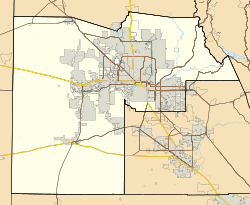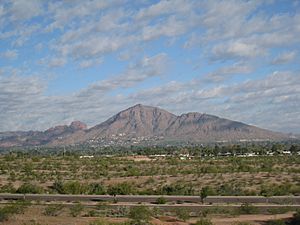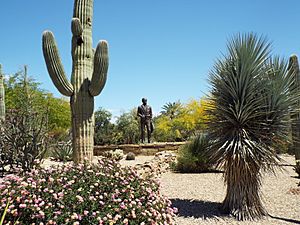Paradise Valley, Arizona facts for kids
Quick facts for kids
Paradise Valley, Arizona
|
||
|---|---|---|
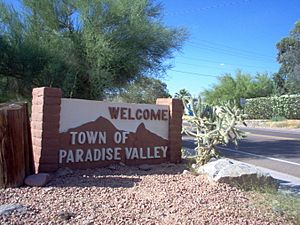
Welcome sign
|
||
|
||
| Motto(s):
"There is a reason we call this valley 'paradise'"
|
||
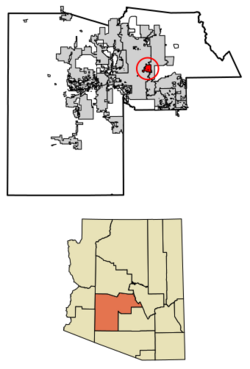
Location in Maricopa County, Arizona
|
||
| Country | ||
| State | ||
| County | Maricopa | |
| Area | ||
| • Total | 15.41 sq mi (39.90 km2) | |
| • Land | 15.38 sq mi (39.83 km2) | |
| • Water | 0.03 sq mi (0.07 km2) | |
| Elevation | 1,854 ft (565 m) | |
| Population
(2020)
|
||
| • Total | 12,658 | |
| • Density | 823.02/sq mi (317.77/km2) | |
| Time zone | UTC-7 (MST (no DST)) | |
| ZIP code |
85253
|
|
| Area code(s) | 480 | |
| FIPS code | 04-52930 | |
| GNIS feature ID | 2413114 | |
Paradise Valley is a beautiful desert and mountain town in Arizona. It's located just east of Phoenix, which is the state capital. This town is famous for its amazing golf courses, great places to shop, and delicious restaurants. In 2020, about 12,658 people lived here.
The name "Paradise Valley" comes from the large, pretty area it's part of. This valley stretches from the Phoenix Mountains all the way to Cave Creek and Carefree in the north, and to the McDowell Mountains in the east. Most kids who live in Paradise Valley go to schools in the Scottsdale Unified School District.
Contents
History of Paradise Valley
The history of Paradise Valley goes back to a time when people mostly farmed and raised animals. After the first European settlers arrived, the land was used for grazing cattle.
How Paradise Valley Got Its Name
In the 1880s, people started surveying the land to turn it into farms. This is when the name "Paradise Valley" was first used. Surveyors from the Rio Verde Canal Company, led by Frank Conkey, gave it this name. They might have chosen it because there were so many beautiful spring wildflowers and palo verde trees in the area.
For a long time, through the 1800s and early 1900s, Paradise Valley was mainly a farming area. After World War II, people started building homes on large plots of land, usually between 1 and 5 acres. This became a well-known feature of the area.
Becoming a Town
As nearby towns like Phoenix and Scottsdale grew bigger and started taking over surrounding areas, the people living in what would become Paradise Valley worried. They didn't want to lose the special qualities of their community if it became part of a larger city.
So, these residents formed a group called the "Citizens Committee for the Incorporation of The Town of Paradise Valley, Arizona." They gathered enough signatures to present their request to the Maricopa County Board of Supervisors. The supervisors agreed, and the town of Paradise Valley officially became a town on May 24, 1961.
Today, Paradise Valley is known as one of Phoenix's wealthiest suburbs.
Geography and Landmarks
Paradise Valley covers an area of about 15.4 square miles (39.9 square kilometers). Only a very small part of this, about 0.03 square miles, is water.
Mountains and Natural Beauty
Mummy Mountain is a very important natural landmark right in the middle of Paradise Valley. Other famous mountains nearby include Camelback Mountain on the southern edge and the Piestewa Peak area on the western edge.
Historical Sites to Explore
Paradise Valley is also home to several interesting historical sites. These include the Harold C. Price, Sr. House, the McCune Mansion (also known as Hormel Mansion), and the Barry Goldwater Memorial Park.
Population and People
| Historical population | |||
|---|---|---|---|
| Census | Pop. | %± | |
| 1970 | 6,637 | — | |
| 1980 | 11,085 | 67.0% | |
| 1990 | 11,773 | 6.2% | |
| 2000 | 13,664 | 16.1% | |
| 2010 | 12,820 | −6.2% | |
| 2020 | 12,658 | −1.3% | |
| U.S. Decennial Census | |||
In 2020, the town had a population of 12,658 people, living in 5,728 households.
In 2000, about 24.9% of the population was under 18 years old. The average age of people living in Paradise Valley was 46 years old.
Education for Students
Most students in Paradise Valley attend schools within the Scottsdale Unified School District. A smaller part of the town is served by the Creighton Elementary School District and the Phoenix Union High School District.
There are also several charter schools and private schools in the area. Some of these include Great Hearts Academies, BASIS Schools, and Phoenix Country Day School.
Economy and Jobs
Paradise Valley has several important employers, mainly in the hospitality industry. These are places like resorts and hotels that welcome visitors.
Top Employers in Paradise Valley
Here are some of the biggest employers in the town as of 2020:
| # | Employer | # of Employees |
|---|---|---|
| 1 | Omni Scottsdale Resort and Spa | 331 |
| 2 | Sanctuary on Camelback | 324 |
| 3 | The Scottsdale Plaza Resort | 283 |
| 4 | Hermosa Inn | 202 |
| 5 | Mountain Shadows | 190 |
| 6 | Double Tree Paradise Valley Resort | 160 |
| 7 | Phoenix Country Day School | 145 |
| 8 | Town of Paradise Valley | 109 |
| 9 | Camelback Inn | 97 |
| 10 | Early Learning Childhood Center | 82 |
Understanding Paradise Valley Names
It's easy to get Paradise Valley, the town, confused with other places that have "Paradise Valley" in their name. For example, Paradise Valley Community College, Paradise Valley High School, and Paradise Valley Mall are all located several miles north of the actual town of Paradise Valley, in Phoenix.
Even the Paradise Valley Unified School District does not serve the town of Paradise Valley itself. Its school boundaries end a few miles north of the town's border.
Famous People from Paradise Valley
Many well-known people have lived in Paradise Valley. Here are a few:
- Michael Bidwill: A businessman and football executive who owns the Arizona Cardinals.
- Alice Cooper: A famous rock singer.
- Sheryl Cooper: A dancer and choreographer.
- Doug Ducey: A politician who was the governor of Arizona.
- Barry Goldwater: A U.S. senator and presidential candidate.
- Bil Keane: The cartoonist who created The Family Circus.
- Kliff Kingsbury: A former head coach for the Arizona Cardinals.
- Leslie Nielsen: A Canadian-American actor.
- Sandra Day O'Connor: A former Justice of the U.S. Supreme Court.
- Michael Phelps: The most successful Olympic swimmer of all time.
- Dan Quayle: A former Vice President of the United States.
- William Rehnquist: A former Chief Justice of the U.S. Supreme Court.
See also
 In Spanish: Paradise Valley (Arizona) para niños
In Spanish: Paradise Valley (Arizona) para niños



